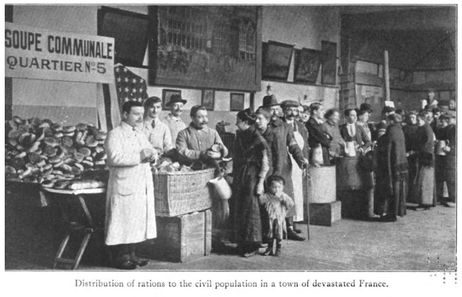 Madeleine Marie Louise Chevrillon Saint-René Taillandier was a woman of letters and French philanthropist. Sister of André Chevrillon and niece of Hippolyte Taine, she married the diplomat Georges Saint-René Taillandier. In 1920, Edith Wharton asked her to translate her novel The Age of Innocence. Saint-René's book,The Soul of the CRB (original En France et Belgique envahies: Les soirées de la C.R.B.(1919) features a main character named Daisy Folk, a flattering version of a charming American who has lived and studied in France, plays violin and quotes Goethe as she mesmerizes those around her. Sound familiar? It should, she was close friends with Daisy Polk. The book describes four Americans and four French enjoying a dinner and philosophically discussing the arrival of America into the War. CRB stands for Committee for Belgian Relief, and she has slightly changed the character names to give her poetic license in telling the story, Excerpted here. It was a woman's voice, clear and full, with a ringing American accent. It was Daisy Folk - "our Daisy," as we called her, who had been in France for two years, one of the first emissaries from the friendship of America. And if we had sometimes doubted, she, Daisy, had always believed, destroyed by fire, a tiny village of Lorraine, on the edge of the forest of Parroy. A generous friend had said to her, “Choose for me, in devastated France, the poorest and most badly wrecked village that you can find,” and, as she might in former days have sought our most precious ornament for this same Californian friend, she had now sought out and chosen the village of Vitrimont,and was re-building it, stone by stone, living meanwhile among our Lorraine peasants. “Yes," said this philosopher,“the Old World made us, and now you will see the re flux of the New World upon the Old, in strength, in mental energy, and in affection. And since you have spoken of the moon in referring to us, you will have the phenomena of the tides. You will be sorry that you ever doubted,” she went on, “and you will see that , thanks to us, this mystery of war and death will be cleared up . ”A flame of faith shone in her eyes.“ But it is thanks to you, ”she added,“ that we feel ourselves to - day a nation. Time and history are the only judges who can tell how much each of us has given to the other.”
There are some profound reflections on the different ways Americans viewed the war from the French. In particular we all learned that the Archduke Ferdinand was shot by a Serb National - and that was the "spark." The French consider it more of an excuse to continue national aggressions between the countries long before any shooting. (Andre) Chevallier in the book tells the Americans - "In America you learn about the world in a textbook. In France we learn it in our mothers womb." If you are interested to read it yourself a free English translation can be found on Google Books here.
0 Comments
Your comment will be posted after it is approved.
Leave a Reply. |
Some stories that couldn't make the book in full ... but need to be told! Editors welcomed - sign up below.
STORIES
WR HEARST PLANS SONG: DAISY HOT SPRINGS 1882 A WILLIS POLK GIFT THE RLS CONNECTION 1896 EARTHQUAKE TALES FROM COPPA PANDEMIC OF 1889 THE BOMB THAT SHOOK SF MILAN:CITY OF WATER POLK ON THE MAP FEATHERS, FASHION & FLY FISHING RARE AVIATION FILM - WWI 1914-17 1906 SAN FRANCISCO WTF FILES - TECHNOLOGICAL GET ME OUTTA HERE! NO HORSES, NO TENTS, NO $ DAISY IN FRENCH LITERATURE DAISY ON FILM! THE WHITE DEATH THE SYMBOLISM OF FLOWERS POSTE DE SECOURS WWI TRAVEL 1900: LONDON TO PARIS DAISY: REST IN PEACE KEITH'S, DRANE'S & KENTUCKY MOTHER: MISSOURI COMPROMISE Topics
All
|

 RSS Feed
RSS Feed